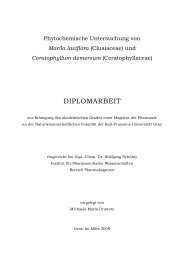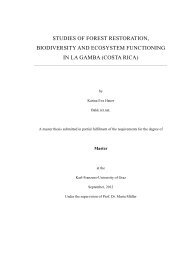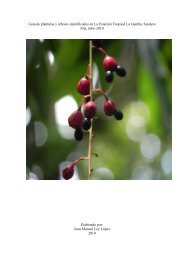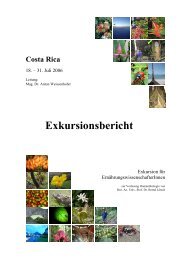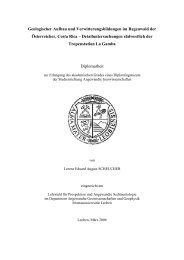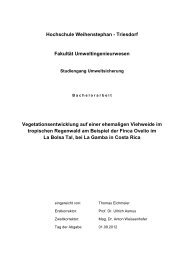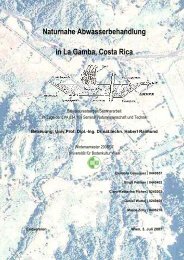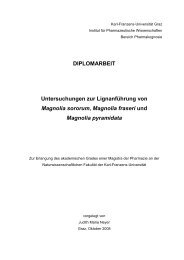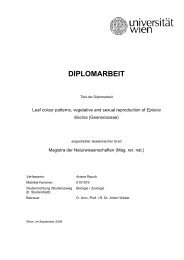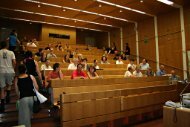Die Tropenstation La Gamba
Die Tropenstation La Gamba
Die Tropenstation La Gamba
Erfolgreiche ePaper selbst erstellen
Machen Sie aus Ihren PDF Publikationen ein blätterbares Flipbook mit unserer einzigartigen Google optimierten e-Paper Software.
<strong>Die</strong> „<strong>Tropenstation</strong> <strong>La</strong> <strong>Gamba</strong>“ in Costa Rica – Wissenschaftlicher Bericht<br />
The Field Guide project could not have been successfully finished without the<br />
participation of Georg Zimmermann. He wrote the greatest portion of the family<br />
treatments. For the introductory part an essay on the geology and geological history of<br />
the Osa Peninsula was written by the geologist Dr. Otto Malzer, and a special chapter on<br />
the soils was contributed by Susanne Pamperl, another student who conducted a diploma<br />
thesis in the Esquinas Forest.<br />
Initially, we restricted our efforts for the Field Guide to the plants within the<br />
Esquinas forest. However, Nelson Zamora, leading botanist of the "Flora of Costa Rica"<br />
project centered at INBio (Instituto Nacional de Biodiversidad, Heredia) recently joined<br />
the project, and the decision was taken to expand the coverage of the Field Guide also to<br />
the Corcovado National Park on the Osa peninsula. Nelson Zamora proved most helpful<br />
and active. He revised the text of many families, helped with plant identifications, made<br />
drawings, slides and maps located at INBio available, and agreed to act as a co-editor.<br />
From INBio we also received support from Reinaldo Aguilar, whose excellent plant<br />
knowledge and field experience proved indispensable, and from Maria Marta Chavarria<br />
Díaz, who helped with plant identifications. Another important Costa Rican institution<br />
that deserves acknowledgement is the Museo Nacional de Costa Rica, San José. The<br />
staff members of the herbarium, Joaquin Sanchez, Armando Ruiz, Alfredo Cascante,<br />
Mariela Bermúdez, Silvia Lobo, and Armando Estrada, as well as Guiselle Alvarado<br />
(Dept. of Ornithology) were most cooperative and helpful through the years. Some even<br />
agreed to act as co-authors and revised certain plant families.<br />
Botanists from other institutions provided support as well, especially Dr. Barry<br />
Hammel (Missouri Botanical Garden, St. Louis), who helped from the onset of the<br />
project with plant identifications and who improved of many of the family accounts. In<br />
addition, we are grateful for the cooperation of Dr. Michael Grayum (Missouri Botanical<br />
Garden, St. Louis), Dr. Robert Dressler (Micanopy, Florida), and Dr. Günther Gerlach<br />
(Botanical Garden Munich).<br />
Special thanks go to the following scientific journals and institutions for<br />
granting permission to reproduce illustrations (line drawings) and maps: Annals of the<br />
Missouri Botanical Garden ("Flora of Panama", Missouri Botanical Garden), Nature,<br />
Tectonophysics (Elsevier Science), Geological Society of America Special Papers<br />
(GSA), Instituto Geográphico Nacional de Costa Rica (Map 2), EcoMapas-Project<br />
(INBio-SINAC) (Map 3), INBio (line drawings by Claudia Aragón) and Missouri<br />
Botanical Garden (line drawings by R.J. Bazan, J.H. Becker, H.J. Cuddy, J.E. Klein, L.<br />
Mourrè, B. Velick, R.J. White, Y.L. Wilson, R. Wise). Map 1 was prepared by Mrs.<br />
Bettina Berger.<br />
Dr. Peter Stütz and Stefan Jirka were most helpful in reading and correcting<br />
large portions of the text. For manifold technical assistance thanks go to (in alphabetical<br />
order) Dr. Ralf Buchner, Stefanie Csekits, Manfred Dworak; Dr. Michael Kiehn, Mag.<br />
Brigitte Krückl, Dr. Veronika Mayer, Matischa Orator, Monika Paschinger, Wolfgang<br />
Prader, Verena Schmelz, and Mag. Susanne Sontag.<strong>La</strong>st but not least, I have to thank the<br />
many institutions and people who supported the project through grants and generous<br />
donations. They are listed on a foregoing page.<br />
We would be happy if the Field Guide would prove to be a valuable<br />
contribution to the appreciation of rainforests and their plant diversity in a relatively<br />
poor and little known region of Costa Rica. May this be another stepping stone to<br />
preserve these complex and vulnerable ecosystems for future generations.<br />
Vienna, November 2001The Editors<br />
Anschrift der Autoren:<br />
Univ. Prof. Dr. Anton Weber, Mag. Werner<br />
Huber, Mag. Anton Weissenhofer, Mag. Georg<br />
Zimmermann<br />
Inst. f. Botanik, Rennweg 14, A-1030 Wien<br />
Tel. ++43-1-4277-54080, Fax. ++43-1-4277-<br />
9541, anton.weber@univie.ac.at,<br />
werner.huber@univie.ac.at,<br />
anton.weissenhofer@univie.ac.at,<br />
georg.zimmermann@univie.ac.at,<br />
Nelson Zamora, INBio - Instituto Nacional de<br />
Biodiversidad, Santo Domingo, Heredia, Costa<br />
Rica, nzamora@inbio.ac.cr<br />
94



